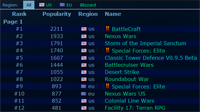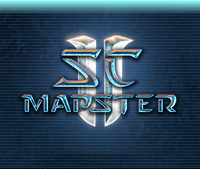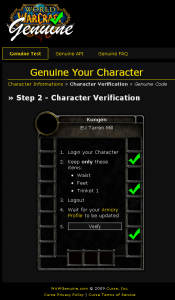Let's get back three months before the beginning of my internship. Blizzard just released the private beta of the long waited real-time strategy (RTS) game Starcraft 2, a remake of their first extremely-successful game. I wanted to run a website for this promising game and started SC2Mapster.com. It is focused around the Map Editor of the game.
Start
I spent countless hours working on custom maps for Warcraft 3, the other RTS franchise from Blizzard. Therefore I decided to run SC2Mapster. I did not start the website from nothing, we adapted a custom web framework called CurseForge that we use for the addon developers. It has built-in support for file hosting, forums, announcements, wiki, etc... Everything needed!
Great, now it's time to get people in. At the time of the launch there were three kinds of competitors: important Warcraft 3 websites about custom maps such as HiveWorkshop, WC3Campaigns or Nibbits, huge portals about Starcraft 2 with a mapping part like TeamLiquid and new sharks like us.
The strategy that I use was to behave like a user. The map editor was not yet released but we could analyze the already existing maps. During this period I started contacting the few users that were hacking the maps and told them to come on the IRC. At the same time I started an effort to document all the parts of the editor. In order to get traffic from outside, I created the first custom map that was not just a basic modification of existing maps: Mapster TD. It has been linked on various non-mapping related websites and the video was viewed 35 000 times.
News
In the early days of Starcraft 2, it was really difficult to know what happened in the modding community. Everyone was working on his own and did not communicate with each other. I spent a lot of time seeking for websites and people that were acting in the area. Since I found some cool projects, I started listing those in the front page of SC2Mapster.
Quickly, people started to visit the website as they wanted to know about the Starcraft 2 map making. At the beginning the majority of links were sending people outside of SC2Mapster. Interestingly, people sticked to our website. They started contributing on the forums thanks to the news I was writing.
As it shows great results, I decided to start writing news at a daily rate. This was quite a challenge as I never had any experience in journalism. At first this was hard. I did not really know where to find good source of information. There were many interesting projects going on but they rarely provided material that was good to show. I started contacting people and ask them to make content that I could news. In 6 months, not a single person did not answer me or did not wanted to do it, this was really impressive!
I found that the best way to show off maps was video. The other options are text or screenshots. Text is painful to read and does not represent well a map. Screenshots are better but it is really hard to show liveliness with it. It is also painful to browse more than 5 screenshots. I decided to use video as primary support, if a project does not have a video then it will not be newsed. About a month after the adoption of that guideline, a lot of project started to do videos. It substantially improved the communication quality of a lot of projects.
Contest
A contest is an effective way to stimulate a community. The Starcraft 2 map editor being powerful, it gives wide range of areas to explore. When a contest takes place, this is the opportunity to make everyone focus on the same objective for a given period of time. This is also a motivator since the entries will be rated and a winner elected.
Contests were organized at a rate of two per month. One week to do the entry, one week to vote. As you can see, all the thirteen contests were unique.
- World of Warcraft Boss Contest September 21st, 2010
- Epic Battle Scene Contest September 2nd, 2010
- Blizzard Custom Map Contest August 13th, 2010
- User Interface Contest August 4th, 2010
- Minigame Contest July 21th, 2010
- Creature Contest June 29th, 2010
- Wallpaper Contest June 17th, 2010
- Spells Contest June 9th, 2010
- 3D Modeling Contest May 26th, 2010
- Melee AI Contest May 25th, 2010
- Cut Scene Contest May 14th, 2010
- Clock Contest May 2nd, 2010
- Inventory Contest April 11th 2010
How to make a good contest
This is hard to organize a good contest.
The most important thing is to define the objective: stimulate the community. The community as a whole needs to participate. The rules of the contest should welcome both the newcomer and the expert. The challenge lies in the huge difference in skill between both, we want to make sure that everyone has a chance to win.
The first step toward this goal is to limit the time of the contest. Giving a week is enough for people to make interesting things, but not enough for a polished product. Therefore all the entries will be prototypes. The concept submission will be remain important factor. A week is also short enough so that people will start working right away, and not be tempted to do it later on, and then forget.
Then the subject is important. It must be balanced between specificity and openness. Each contest should have a specific theme so people have the feeling that they are competing on the same field. But it should give the opportunity to innovate. You want to vary the themes of your contests and make them cover all the features of the domain.
Since not everyone will participate, we make people vote for the best entry. This voting phase will show all the entries to the community. The results will be biased as people who vote will probably judge only with the provided videos and not test the map. But this is not important as the goal is to get people involved!
Incentives. I found out that people would gladly enter the contest even if there was no real prize. Being highlighted in the front-page of sc2mapster is motivating enough. If we were to put cash prizes, people would be less likely to do it for fun but try instead to abuse the system to win.
Finally, listen to the community. A lot of people came to me with contest ideas. However take care, most of them will not be good contests. Make sure you adapt them to fit all the rules I highlighted and eventually they will be good to go.
Moderation
The site got bigger. At one message per minute at peek hours, it was no longer able to review all the messages that were posted. Therefore it became difficult to moderate the forums.
We made a call for moderators and we were really surprised that 40 people applied. It was a tough decision to chose them. In the end one moderator was assigned for each forum, and three for the most active one. Using the activity count and their preferences we picked 13 out of all the applicants.
I had great faith in the moderators we took and wanted to give them the ability to conduct a project of their choice. It would be advertised on the front-page and labeled as an official SC2Mapster project. However this failed. This was more perceived as a constraint instead of an opportunity. It also confused them as to what were their role.
Another mistake we made was a lack of communication. We did not force the moderators to go into our private IRC channel. Therefore we were not able to create a group feeling. This was amplified by the timezone differences: the Europeans rarely talked to the Americans.
Even if I wasn't a really good manager, they did an awesome job at moderating the forums.





